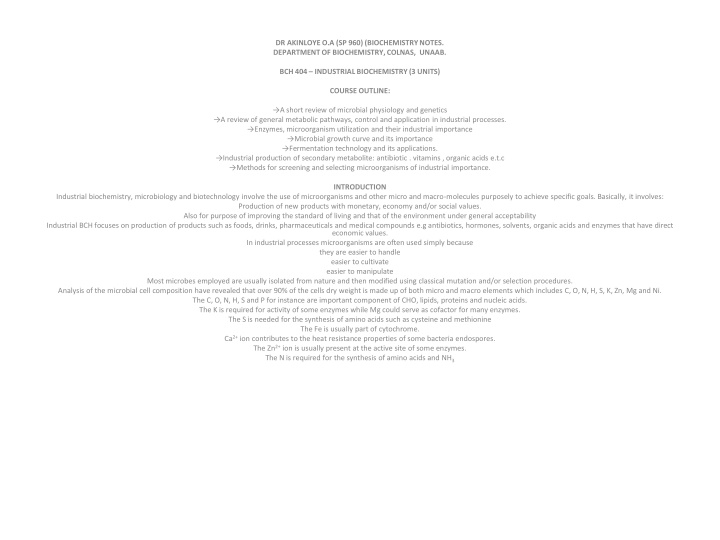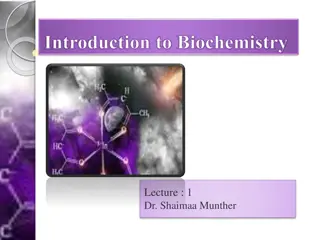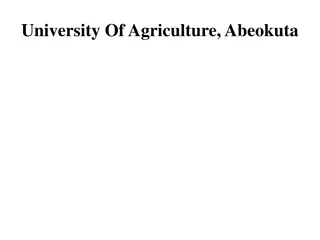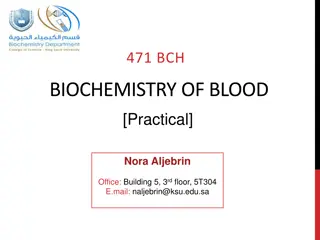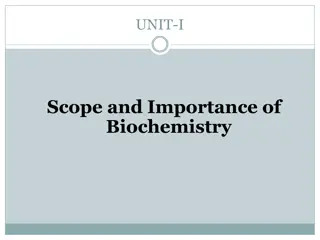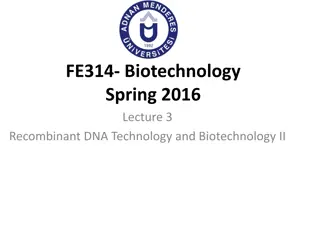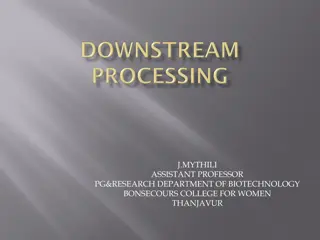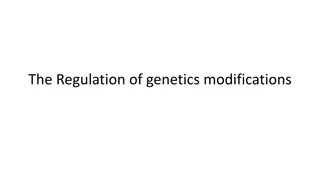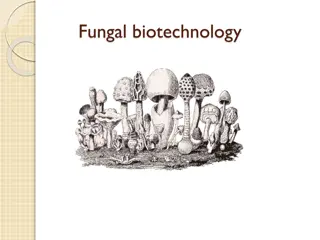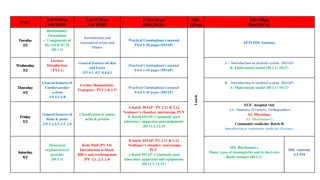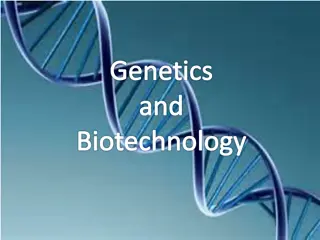Overview of Industrial Biochemistry and Biotechnology
This course outline covers key topics in industrial biochemistry, microbiology, and biotechnology, focusing on the use of microorganisms and molecules to achieve specific goals in production processes. It delves into microbial physiology, genetics, metabolic pathways, enzymes, microbial growth, fermentation technology, and industrial applications. The importance of elements, vitamins, and enzymes in industrial processes is highlighted, along with the significance of selecting and screening microorganisms. Industrial biochemistry plays a vital role in producing economically valuable products like antibiotics, hormones, organic acids, and enzymes, contributing to societal and environmental well-being.
Download Presentation

Please find below an Image/Link to download the presentation.
The content on the website is provided AS IS for your information and personal use only. It may not be sold, licensed, or shared on other websites without obtaining consent from the author.If you encounter any issues during the download, it is possible that the publisher has removed the file from their server.
You are allowed to download the files provided on this website for personal or commercial use, subject to the condition that they are used lawfully. All files are the property of their respective owners.
The content on the website is provided AS IS for your information and personal use only. It may not be sold, licensed, or shared on other websites without obtaining consent from the author.
E N D
Presentation Transcript
DR AKINLOYE O.A (SP 960) (BIOCHEMISTRY NOTES. DEPARTMENT OF BIOCHEMISTRY, COLNAS, UNAAB. BCH 404 INDUSTRIAL BIOCHEMISTRY (3 UNITS) COURSE OUTLINE: A short review of microbial physiology and genetics A review of general metabolic pathways, control and application in industrial processes. Enzymes, microorganism utilization and their industrial importance Microbial growth curve and its importance Fermentation technology and its applications. Industrial production of secondary metabolite: antibiotic . vitamins , organic acids e.t.c Methods for screening and selecting microorganisms of industrial importance. INTRODUCTION Industrial biochemistry, microbiology and biotechnology involve the use of microorganisms and other micro and macro-molecules purposely to achieve specific goals. Basically, it involves: Production of new products with monetary, economy and/or social values. Also for purpose of improving the standard of living and that of the environment under general acceptability Industrial BCH focuses on production of products such as foods, drinks, pharmaceuticals and medical compounds e.g antibiotics, hormones, solvents, organic acids and enzymes that have direct economic values. In industrial processes microorganisms are often used simply because they are easier to handle easier to cultivate easier to manipulate Most microbes employed are usually isolated from nature and then modified using classical mutation and/or selection procedures. Analysis of the microbial cell composition have revealed that over 90% of the cells dry weight is made up of both micro and macro elements which includes C, O, N, H, S, K, Zn, Mg and Ni. The C, O, N, H, S and P for instance are important component of CHO, lipids, proteins and nucleic acids. The K is required for activity of some enzymes while Mg could serve as cofactor for many enzymes. The S is needed for the synthesis of amino acids such as cysteine and methionine The Fe is usually part of cytochrome. Ca2+ion contributes to the heat resistance properties of some bacteria endospores. The Zn2+ion is usually present at the active site of some enzymes. The N is required for the synthesis of amino acids and NH3
Apart form these elements, microorganisms also required other source(s) for growth, in order reflect some special nature of their morphology. Other compounds such as vitamins are also utilized by microbes. For instance, biotin is necessary for carboxylation of one carbon metabolism in Leuconostoc mesenteroides while folic acid which is for transfer of acyl group is required by Lactobacillus casei. More so, thiamine (vit. B1) is involved in the transfer of aldehyde group in Onchomonas mellamensis while pantothenic acid serves as precursor of CoA in paramecium species. ENZYMES AND MICROORGANISMS UTILIZATION IN THE INDUSTRY It should be noted that industrial pracises are often confidential and information from any publication with regard to any industrial processes may be scarce or negligible. However, enzyme preparation of suitable purity and cost can be chosen in such a favorable case so as to achieve the desired chemical conversion without formation of toxic or dangerous or deleterious side products. This is often obtained by putting factors such as temperature, pH as well as activator(s) and/or inhibitor(s) at the right level and range. Enzymes have been known to excel in their ability to alter chemical components of foodstuffs. For instance, the protein, fat and cellulose presence in food are ready made substrate for protease, lipases and cellulase respectively. Furthermore, most natural products have been known to be biodegradable due to the action of enzymes inherent in environmental microorganisms. Thus, production of substances of good economic, social and commercial values in the industrial processes have been made possible by combining the right organism and inexpensive substrate (like some waste product e.g mollases, saw-dust) and proper environment for both the enzyme and organisms involved in the industrial process. For instance, in fermentation, transformation of organic raw materials (substrate) by microorganism is usually carried out in a controlled favorable environment (created by fermentor) in order to form desired end product(s). CHOICE OF ENZYME AND ITS CONTROL Substantial biochemical efforts are needed in order to understand the choice of enzyme in the context of the process or products desired. This required fundamental research efforts into classical parameters of enzyme kinetics under working condition such as pH and temperature optimum, Km, Vmax, presence or absence of inhibitor(s) and/or activator. Also, the structure and nature of enzyme in relation to its mode of catalytic functions needs to be understood. In addition, in most cases, before an enzyme is added or used in food or food related processes, its level of toxicity is normally assessed It should be noted that the task of regulatory machinery is a bit complex and the pathway must be regulated and co-coordinated effectively such that all the cell components and other required materials would be present in precisely or relatively correct amount. Furthermore, a microbial cell is expected to respond to the environmental changes by using the nutrients present at a particular moment. It therefore meant that it must possess ability to synthesis as well as alter biosynthetic activity in response to changes in nutrient availability. Note that regulation is necessary for the cell to conserve microbial energy and materials maintain metabolic balance prevent over/under production of materials save cost avoid production of toxic substances. e.t.c For instance, if a particular energy source is unavailable, the enzyme required for its use(s) are not needed and further synthesis of such is a waste of C, N and energy. Similarly, it will be extremely wasteful for microorganism to synthesize the enzyme required to manufacture a certain product if that product(s) were already present in adequate amount. Note that there are at least three (3) means of controlling or regulating enzymes of industrial importance thus: feedback inhibition covalent modification allosteric control or regulation
Feedback inhibition: This is a process whereby a reaction pathway is inhibited by the final product. It usually involves inhibition of the enzyme catalyzing the first or earlier part of the pathway. OR A process whereby the end product control the metabolic flux by inhibiting one or more of the enzyme catalyzing the first reaction of the pathway. There exist at least four (4) types of feedback inhibition namely: sequential feedback inhibition concerted feedback inhibition cumulative feedback inhibition and synergistic feedback inhibition (REFER TO BCH 405 i.e REGULATION OF METABOLIC PATHWAYS for more details. The principal uses of enzymes in industries involves among others: -for alcoholic beverages production - for bread making -for cheese making - for meat tenderizing - as sweetners - for clarification of beer, wine and fruit juice - for production of detergent - for medical application e.g use of trypsin as an anti-inflammatory agent and wound cleanser; streptokinase from streptococcus haemolyticus is used to relief peripheral thrombosis. The summary of some enzymes with their corresponding industrial applications is given below: INDUSTRIES Baking ENZYMES USES fungal protease Fungal x-amylase Lipoxidase soften dough general improvement whitens bread Brewing bacterial x-amylase liquefaction cereal Bacterial protease Fungal amyloglucosidase Papain b-glucanase bacterial x-amylase Fungal amyloglucosidase Inveetase rennin Catalase adjuncts removal of dextran from wort or beer chill haze stability lowers viscocity of wort or beer Syrups solbilise starch at high temperature to complete the conversion of starch to convert sucrose to invert sugar Cheese curds milk by precipitation removes H202 from milk to remove crystallised lactose general improvement Ice cream Fruit Vegetable Egg Meat lactose pectinase cellulose softening and flavour promotion removes glucose. glucose oxidase papain tenderization
Textile Paper Laundering Medical bacterial x-amylase bacterial x-amylase bacterial proteases desizing dextran adhesive protein stain removal various uses BACTERIAL GROWTH CURVE Since industrial processes involved the use of microbes,, it is important to have idea of the nature of their growth pattern in order to know when and how best to cultivate, manipulate and handle them for the required process. In the laboratory for instance, under favorable conditions, a growing bacterial population is usually double at regular interval. Also note that the growth is usually by geometric progression i.e 1, 2, 4, 8, 16 e.t. c This type of growth is called exponential growth and in most cases, it is only part of bacteria life cycle and not total representation of the normal pattern of bacterial nature. When a fresh medium is inoculated with a given number of bacteria cells and the population growth is monitored over a given period of time. The plot of logarithm of viable cells/ml against time (hrs) could be represented as shown below: There are four (4) characteristic phases of the growth curve namely: Lag phase Exponential phase Stationary phase Death phase LAG PHASE: Immediately after inoculation of the cells into fresh medium, the population remain temporarily unchanged. Although, there is no apparent cell division occurring, however, the cells may be growing in volume or mass, synthesing enzymes, proteins, RNAs e.t.c. This will bring about increase in metabolic activities. Note that the length or period of lag phase depends on some factors such as : the size of the inoculums the time necessary for the cell to recover from physical damage or shock during transfer the time required for the synthesis of essential co-enzymes or division factors the time required for the synthesis of inducible enzymes that are necessary to metabolize the substrate presence in the medium.
EXPONETIAL (LOG) PHASE: This is the portion of the bacteria growth curve that demonstrates a pattern of balanced growth wherein all cells are dividing regularly by binary fission and are grown by geometric progression. The cells divide at a constant rate depending on : the composition of the growth medium the condition of inoculation The rate of exponential growth of a bacterial culture is expressed as Generation time (G) which is defined as the time (t) per generation and given by the expression: G=t/n Where n is the number of generation and is equal to (n=3.3 log b/B. Where t = time interval in hrs or mins B = number of bacteria at the beginning of a time interval b = number of bacteria at the end of time interval G = number of generation (number of times the cell population doubles during the time interval) STATIONARY PHASE: Since exponential growth curve cannot continue forever, the population growth is therefore limited by at least three (3) factors namely: availability of essential nutrients accumulation of inhibitory metabolite or end product lack of biological space It should be noted that it is during the stationary phase of the growth curve that the bacteria produces secondary metabolites such as antibodies that the spore forming bacteria induces or unmasks the activities of several genes that may be involved in other metabolic processes. DEATH PHASE; If incubation continues after the population reaches stationary phase, a death phase is bound to follow during which the viable cells population declines. This usually comes into play since there would not be enough biological space and the nutrients available will not be sufficient for the existing/viable cells. Note that the generation time for bacteria varies from about 12 minutes to 24 hrs or more depending on the : culture medium temperature pH Microorganism itself. The generation time for some bacteria under optimum condition s is given below:
BACTERIUM Escherichia coli Streptococcus lactis Bacillus megaterium Streptococcus lactis Rhizodium paponicum Treponema pallidum MEDIUM GENERATION TIME glucose-salts milk sucrose-salt lactose broth 17 minutes 26 minutes 25 minutes 48 minutes mannitol-salt 344 minutes rabbit testis 1980 minutes The importance of these phases is that it will enables one to have ideas as to the appropriate time to culture, harvest and manipulate the microorganism concern in relation to the desired enzyme(s) and/or other product(s). ILLUSTRATION What is the generation time of bacteria population that increases from10,000 cells to 10,000,000 in four hours of growth? Solution: Since n = 3.3 log b/B Then n = 3.3 log 10,000,000/10,000 Therefore n = 3.3 log 1000 Thus, n = 3.3x3 = 9.9 Therefore G = 4/9.9 = 0.404 hrs = 24.24 minutes CONTROL OF MICROBIAL GROWTH The control of microbial growth could be effected basically by the use of either chemical agents or physical agents And this could involve the use of inhibitory agents or by physical killing agents. Agents that kill cells are called cidal agents while those that inhibits growth of cell without killing the are called static agents. Definition of terms: Sterilization: This is the process by which living cells, viable spores and viruses are either destroy or remove from an object or habitat in such a way that the object will be totally free from any form of viable microorganism. Chemical agents used to sterilization are called sterilant Disinfection: This is the killing, inhibition or removal of micro-organism that may cause disease and the chemical agent used for that are called disinfectant. Note that a disinfectant does not necessarily sterilize an object because viable spores and a few micro-organisms may remain and disinfectants are normally used on inanimate objects
Antiseptics: These are chemical agents commonly applied to tissues to prevent infection by killing or inhibiting the growth of such pathogen. Antiseptics are generally not as toxic as disinfectants since they do not, in most cases, destroy the host tissues. Physical methods of control includes among others; application of heat low temperature (refrigeration and/or freezing filtration Radiation. Application of heat: Use of moist or dry heat has been known to be able to kill viruses, bacteria and fungi. Exposure to boiling water for about 10 minutes is enough to destroy vegetative cells but may not be high enough to destroy bacteria endospores. Most food processing industries used to combine the two methods of moist and dry heat applications in order to eliminate completely the risk of contamination. Dry heat has the advantages in the it can be used to sterilize compounds like powder and oil. Also, it can be used to on glass ware and metal without corrosion. Refrigeration and/or freezing Low temperature is only good for short term storage of food and other items since it only slows down microbial growth. However, freezing at about 200C or lower would stop microbial growth completely. Thus, freezing is a very good method for long term storage, if properly carried out. Filtration: This is an excellent way of reducing microbial population especially in solution of heat sensitive materials. Two types are known namely: Depth filter which consist of fibrous or granular materials. Membranes filter which consist of porous membrane made of cellulose acetate, cellulose nitrate or other synthetic materials. It is commonly use for oil, antibiotics and other heat sensitive materials or solutions. Radiation: These are of two types: Ultra-violent which is used in only a few specific situations because it burn skin and could damage the eye. Though, commercial UV unit is often used in water purification Ionizing radiation which could penetrate and sterilize subjects by destroying the cell nature be it the endospore or the vegetative cells. Gamma radiation from cobalt-60 source is used in cold sterilization of antibiotics, hormones and plastic disposable substances such as syringes. USE OF CHEMICAL AGENTS Although, chemicals agent meant to be used should be toxic to the pathogen, it should not be toxic to the people. Effective and continuous use of some chemical agents has led to frequency of antibiotic resistance in some cases. Examples of chemical often used are phenolics and hexachlorophene. Some of these agents act by denaturing proteins. However, they have disadvantages in having offensive odor and in being able to cause skin irritation and brain damage.
The summary of some chemicals often used in controlling microbial growth is given below: CHEMICAL Ethanol dentures protein and solubilise lipids Isopropanol denatures protein and solubilise lipids antiseptics used on skin Formaldehyde reacts with NH2, -SH groups Chlorine gas oxidizing agent HgCl2 inactivate protein NH4compd disrupts cell membrane Ethylene oxide alkylating agent ACTIONS USES antiseptic used on skin disinfectant,kills endospore disinfect drinking water disinfectant on skin skin antiseptics disinfectant on rubber/plastics . Commonly used preservatives are also summarized below: PRESERVATIVES Propionic acid Sorbic acid Benzoic acid Lactic acid Sulfur dioxide Sodium nitrite Sodium chloride Wood smoke CONCENTRATION USES 0.32% antifugal agent in bread, cake 0.2% antifugal agent in syrup, cheese 0.1% 0.1-10% 200-300ppm 200 ppm unknown unknown antifugal in margarine, relishes antimicrobial in yoghurt antimicrobial in dried fruits antimicrobial in meat and fish prevents spoilage of fish, meat prevents spoilage of fish, meat. COMMONLY USED CHEMOTHERAPEUTIC AGENTS CHEMICAL CLASS B-lactams Clavulanic acid Aminoglycosidase Macrolides Rifamycins Tetracyclines Chloramphenicol Monobactams EXAMPLE penicillin, cephalothin clavamox, amoxicillin streptomyces erythromycin MODE OF ACTION inhibits cell wall synthesis inhibits betalactomases inhibits translation inhibits translation rifampicin inhibits transcription tetracycline chloramphenicol aztreonam inhibits translation inhibits translation. inhibits cell wall synthesis
FERMENTATION AND ITS INDUSTRIAL APPLICATIONS Fermentation is a metabolic process in which energy is derived from partial oxidation of an organic compound using immediate as electron donors or electron acceptors. It occur by substrate level phosphorylation in which the substrate is oxidized and ATP is form directly from the reaction. A typical example is the conversion of glucose to two molecules of lactate which is accompanied with the production of two mole of ATP Glucose 2 pyruvate 2 lactate (resultant 2ATP is produced). Note that abundant and renewable sources of fermentable carbohydrate are plant starch, cellulose from agricultural wastes; molasses from sugar and whey fro cheese manufacturing industries. Processes of fermentation take place in a Fermentor or Bioreactor. A fermentor is described as a vessel designed to carry out fermentation processes under biological controlled conditions. It is designed to maximize yield. It is operated under aseptic condition with adequate agitation and regular or appropriate supply of nutrients. It has pH and temperature control units or system with drain or over-flow facilities A fermentor has adequate mass transfer and work best in sterile environment. It has gentle heat transfer with optimum mixing with low and uniform shears. The diagram of a typical fermentor is shown below. Classification of bioreactor could be based on a number of criteria among which are: type and form of biocatalyst e.g free cells in submerged configuration of the bioreactor such as the tank height, diameter as well as the column size. The nature of energy input required i.e in form of liquid, gaseous or combined Hydrodynamics i.e perfect mixing or partial mixing or no-mixing al all. The mode of operation which could be in form of batch or continuous or feed-batch mode of operation. TYPES OF BIOREACTOR/FERMENTOR STIRRED TANK BIOREACTOR (STB): This is used industrially for production of human therapeutic proteins e.gtissue plasmogen activator and usually made of stainless steel constructed with a working volume of about 2000-5000 litres. AIR LIFT BIOREACTOR (ALB): It is similar to STB, but in term of dimension is usually longer than STB and it has a kind of bullet shape, thus, uses air sparked at the bottom as a mixing device. FLUIDIZED BED BIOREACTOR (FBB): This is often a plastic bioreactor used in industrial up-stream processes on cells that are fixed in a compartment or media which is constantly pumped into the bioreactor, while the product is also constantly withdrawn and pulled for down-stream process. HOLLOW-FIRBRE BIOREACTOR: In this case, the cells are grown inside hollow-fibre or tubes and media is pumped either through the hollow fibre and the product is constantly withdraswn and pulled for down-stream processing PACKED CELL BIOREACTOR (PCB):This is commonly used with attached biofilms especially in waste water engineering. It involved packing of immobilized bio-catalyst in a column after which it is fed with nutrients be it from top or below. However, one of the disadvantage is the change in flow characteristics that could be observed as a result of alteration in bed porosity during operation.
SELECTION OF BIOREACTOR The preliminary choice of a bioreactor depends on a number of factors which includes: physiological state of the cell sterility value or desired product culture and culture medium metabolic state product formation kinetics processing method i.e if it is batch, fed-batch or continuous method reaction and processing area or application bubbles dispersion and foam control biological i.e substrate dosage and energy dissipation. SOME UNIQUE ASPECTS OF BIOLOGICAL PROCESSESS IN A BIOREACTOR It should be noted that certain substances such as inhibitors, effector molecules, precursors and metabolic product(s) could influence the rate and mechanism of reaction as well as intracellular regulations taking place in the bioreactor Also, some microorganism can metabolized unconventional or even contaminated raw materials to yield useful products. Microorganisms can adapt the structure and activity of their enzymes to the process condition(s), thereby making the selectivity and productivity change. In some cases mutation could set in especially under sub-optimal biological conditions. Furthermore, cell growth, the structure of intracellular enzyme and product formation depend not only on the nutritional needs of the cell but also on the maintenance of optimum biological condition within narrow limits. Finally, it should be noted that microorganisms are frequently sensitive to strong shear stress, thermal and chemical influences.
